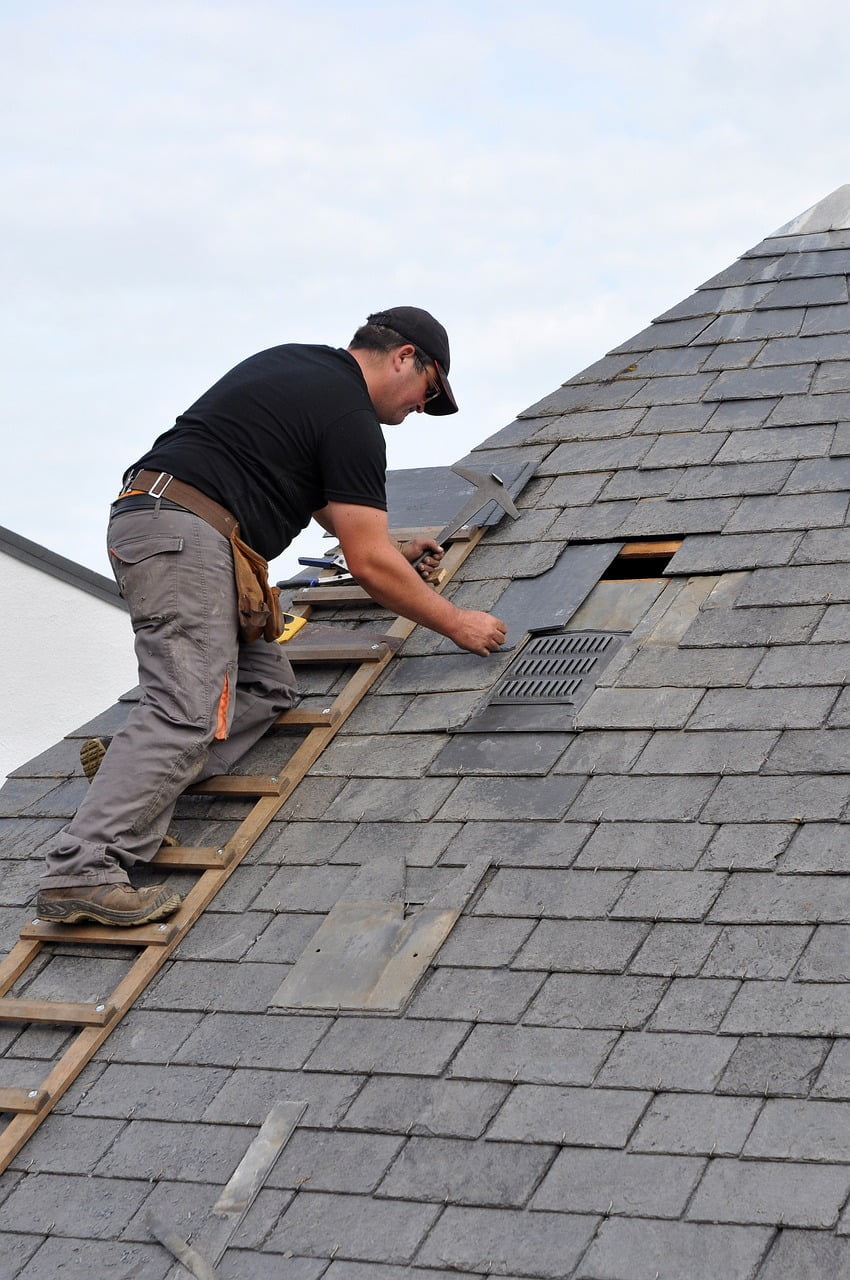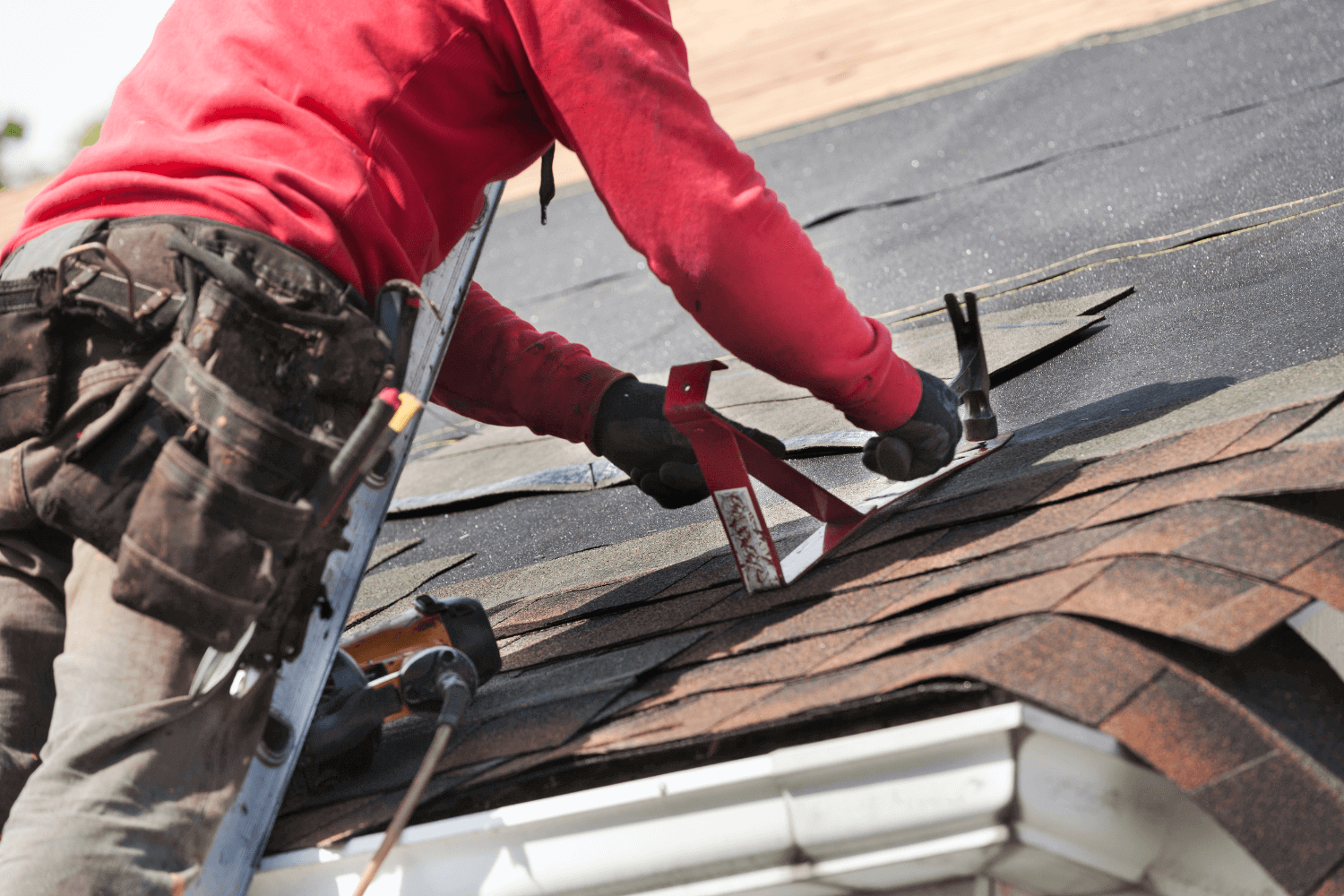Seasonal Roof Covering Repair Work Checklist: Prepare Your Roofing System for Every Weather Condition
By complying with a seasonal roofing repair work checklist, you can stay ahead of possible concerns. Let's discover how correct upkeep can safeguard your home and prolong your roofing system's lifespan.
Checking Your Roofing for Winter Months Preparedness
As winter months methods, it's important to check your roofing system to confirm it can hold up against harsh weather condition conditions. Start by looking for missing or harmed shingles; also a tiny issue can bring about considerable leakages when snow and ice accumulate. Next, analyze the flashing around vents and smokeshafts-- this area is usually vulnerable to water invasion.
Do not neglect to look for indications of drooping or unequal surfaces, as these may suggest architectural troubles. Furthermore, validate your seamless gutters are clear; stopped up rain gutters can bring about ice dams that harm your roofing.
 roof repair
roof repair
Springtime Cleansing: Clearing Particles and Checking for Damages
When winter months's grip releases, it's time to tackle spring cleansing on your roofing system by removing away debris and checking for any type of damage. Beginning by examining your roofing for dropped branches, leaves, and various other debris that can trap wetness and trigger rot. A tidy roofing system promotes far better drain and stops mold and mildew growth.
Next, get a tough ladder and thoroughly inspect tiles for cracks or missing items. Pay interest to locations around vents and chimneys, as these spots are vulnerable to leakages. Don't neglect to analyze your rain gutters, ensuring they're devoid of blockages that might cause water pooling.
While you're up there, seek indicators of wear, like corrosion on steel blinking or loosened seals around skylights. Addressing them currently can conserve you from pricey repair services later if you detect any kind of issues. A little spring cleansing goes a long method in keeping your roof covering's integrity.
Summer Heat: Analyzing Your Roof Covering for Heat-Related Issues
As summer season heat heightens, it's vital to check your roof for heat-related issues. Look for any kind of roof shingles damages, try to find signs of heat buckling, and evaluate how well your roof ventilates. Taking these steps now can stop larger issues down the road.
Evaluate for Shingle Damage
 roof repair
roof repair
Inspect for Warm Fastening
Warm buckling is a typical concern that can arise throughout the scorching summertime months, and it's essential to examine for it on your roofing system. Begin by evaluating your roof covering visually; look for any unequal surfaces or lifted edges. If you find any kind of indications of warmth fastening, it's essential to address them quickly to avoid additional damages.
Examine Roofing Air Flow Performance
After examining for warm fastening, it's vital to evaluate your roof's air flow effectiveness. Appropriate air flow aids manage temperature and moisture, avoiding damage from excessive heat. Bear in mind, keeping great ventilation not only lengthens your roofing's life yet likewise enhances your home's overall energy efficiency, assuring comfort during those hot summertime months.
Rainy Season Preparedness: Ensuring Proper Water Drainage
As the stormy period methods, you need to assure your roof's drainage system is prepared to take care of heavy rainstorms. Beginning by evaluating your downspouts and rain gutters, and make sure they're free from debris. Do not fail to remember to examine the blinking and seals to prevent leaks and water damages.
Examine Gutters and Downspouts
During the wet season, it is crucial to on a regular basis evaluate your rain gutters and downspouts to assure correct drainage. Begin by looking for any noticeable particles, like branches or leaves, that could obstruct the flow of water. Make certain the rain gutters are securely connected and free from sagging, as this can catch water and result in leakages. Next, take a look at the downspouts for obstructions or damages; an obstructed downspout can cause water to overflow, possibly damaging your roofing and structure. Also, verify that downspouts straight water far from your home's structure. If you identify any kind of problems, address them promptly to avoid costly fixings. When hefty rains struck., a little upkeep now can save you large headaches later.
Tidy Roofing System Surface Debris
To guarantee your roofing can handle the stormy period, it's necessary to clean any kind of debris from the surface area routinely. Leaves, twigs, and dust can collect, obstructing drainage paths and creating water to swimming pool. This trapped water can cause leaks and damages with time. Get a durable ladder and evaluate your roofing system for any kind of accumulation. Use a roof rake or mop to carefully remove debris, bewaring not to harm the roof shingles. Don't forget to check your seamless gutters as well, ensuring they're clear and operating effectively. After cleaning, monitor your roofing after hefty rainfalls to detect any type of potential issues early. Keeping your roof covering free from debris is essential for stopping pricey fixings down the line.
Examine Flashing and Seals
After removing your roof of debris, take a closer take a look at the flashing and seals around vents, smokeshafts, and skylights. These areas are vital for stopping leaks throughout the wet season. Inspect the blinking for any signs of rust, fractures, or voids. It's crucial to fix or replace it promptly if you notice any kind of https://hermancainexpress.com/ll-roofing-delivering-excellence-in-roofing-solutions-for-gainesville-and-beyond/ damage. Next, examine the seals; they need to be undamaged and tight. Seek any peeling or damaged locations that may allow water to permeate in. If you locate any kind of compromised seals, take into consideration resealing them with a high-quality roof covering sealer. Ensuring these components remain in excellent problem will certainly help keep proper drainage and protect your home from water damages throughout heavy rains.
Checking and Keeping Roofing Seals and Flashing
While it might seem easy to overlook, maintaining and inspecting roofing seals and flashing is vital for preventing leaks and water damages. If you identify any kind of problems, it's ideal to reseal them with ideal roof sealer to guarantee a limited fit.
Next, analyze the blinking, which routes water far from critical locations. Look for corrosion, loose areas, or curved sides. If you find any damaged blinking, change it or secure it effectively to preserve its stability. Bear in mind, also a small defect can bring about significant issues later on.
Finally, don't forget to wipe any type of debris that might obstruct the seals or blinking. Keeping these elements healthy will certainly help secure your roofing system versus the components and expand its lifespan.
Rain Gutter Upkeep: Maintaining Water Streaming Efficiently
Because your gutters play an important function in routing rain away from your home, routine maintenance is important for protecting against water damages and structure concerns. A stopped up seamless gutter can lead to water overflow, which might harm your roofing system and house siding.
If you see any damage, fixing or change the affected components quickly. Validate downspouts are routing water at least six feet away from your foundation.
Lastly, examine that your rain gutters are effectively sloped, preferably a quarter inch for each 10 feet. This slope warranties water flows efficiently towards the downspouts. Normal upkeep will certainly maintain your gutters operating efficiently and shield your home from expensive repair work.
Scheduling Professional Evaluations for Comprehensive Treatment
Frequently organizing specialist assessments is essential for maintaining your roofing system's integrity. This timing enables you to resolve any damages triggered by winter season weather or summertime storms.
During assessments, specialists will certainly evaluate roof shingles, blinking, and ventilation, making sure whatever's in top form. They'll also inspect for indications of wear, leakages, or mold and mildew, which you might forget. Setting up these evaluations not only expands your roofing system's life-span however also offers you comfort.
If you're not sure about the condition of your roofing, don't hesitate to call a professional. Purchasing these exams currently can conserve you a great deal later. Prioritize your roofing system's wellness, and you'll be well-prepared for whatever weather comes your way.
Frequently Asked Questions
How Typically Should I Evaluate My Roof Throughout the Year?
You must check your roofing at the very least two times a year, ideally in springtime and fall. After severe weather occasions, look for damage as well. Regular examinations assist you capture problems early and conserve money on repairs.
What Indications Indicate I Required a Roofing Substitute As Opposed To Fixing?
 roof repair
roof repair
Can I Perform Roof Covering Fixes Myself, or Should I Employ a Specialist?
You can do minor roofing system fixings yourself if you're comfy with elevations and basic tools, yet working with a professional assurances safety and correct job. Do not take the chance of damages; it could be worth the investment for satisfaction.
What Are the Best Products for Roofing System Fixes in Different Environments?
For different environments, you'll want materials like asphalt tiles for modest areas, steel roofing for extremes, and clay floor tiles for hot regions. Constantly consider neighborhood weather condition patterns to ensure your roof covering stands up to the components properly.
How Do Roofing System Guarantees Affect Seasonal Upkeep Responsibilities?
Roofing system warranties usually define upkeep duties, so you'll require to assess the terms. If you do not preserve your roofing system as called for, you might void the guarantee, leaving you liable for pricey repairs.
Seasonal Roof Covering Repair Service Checklist: Prepare Your Roofing for Every Climate
Once winter season's hold releases, it's time to take on springtime cleaning on your roof covering by clearing away debris and inspecting for any damage. Check for any type of roof shingles damage, look for indications of warmth fastening, and assess how well your roofing ventilates. If you detect any problems, think about calling a professional for repair work to keep your roofing in top shape and secure your home from potential water damage.
While it could seem easy to neglect, examining and keeping roofing seals and flashing is essential for avoiding leakages and water damage.